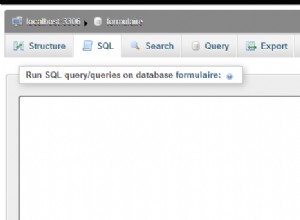केवल तभी जब आपके पास 10000 से कम ईमेल हों.... क्या यह स्वीकार्य है?
select
if(t1.c > 1, concat(e.employeename, ' (', e.employeeid, ')'), e.employeename) as Employee,
replace(substring(substring_index(e.EmailAddresses, ',', n.row), length(substring_index(e.EmailAddresses, ',', n.row - 1)) + 1), ',', '') EmailAddress
from
(select employeename, count(*) as c from Employees group by employeename) as t1,
(select EmployeeID, length(EmailAddresses) - length(replace(EmailAddresses,',','')) + 1 as emails from Employees) as t2,
(SELECT @row := @row + 1 as row FROM
(select 0 union all select 1 union all select 3 union all select 4 union all select 5 union all select 6 union all select 6 union all select 7 union all select 8 union all select 9) x,
(select 0 union all select 1 union all select 3 union all select 4 union all select 5 union all select 6 union all select 6 union all select 7 union all select 8 union all select 9) x2,
(select 0 union all select 1 union all select 3 union all select 4 union all select 5 union all select 6 union all select 6 union all select 7 union all select 8 union all select 9) x3,
(select 0 union all select 1 union all select 3 union all select 4 union all select 5 union all select 6 union all select 6 union all select 7 union all select 8 union all select 9) x4,
(SELECT @row:=0) as ff) as n,
Employees e
where
e.employeename = t1.employeename and
e.employeeid = t2.employeeid and
n.row <= t2.emails
order by e.employeeid;
संपादित करें:
कम बेकार संख्या उत्पन्न होने के साथ:
select
if(t1.c > 1, concat(e.EmployeeName, ' (', e.EmployeeID, ')'), e.EmployeeName) as Employee,
replace(substring(substring_index(e.EmailAddresses, ',', n.row), length(substring_index(e.EmailAddresses, ',', n.row - 1)) + 1), ',', '') as EmailAddress
from
(select EmployeeName, count(*) as c from Employees group by EmployeeName) as t1,
(select EmployeeID, length(EmailAddresses) - length(replace(EmailAddresses,',','')) + 1 as emails from Employees) as t2,
(select `1` as row from (select 1 union all select 2 union all select 3 union all select 4) x) as n,
Employees e
where
e.EmployeeName = t1.EmployeeName and
e.EmployeeID = t2.EmployeeID and
n.row <= t2.emails
order by e.EmployeeID;
और हमने क्या सीखा? खराब डेटाबेस डिज़ाइन के परिणामस्वरूप भयानक प्रश्न होते हैं। और आप SQL के साथ सामान कर सकते हैं, जो शायद केवल इसलिए समर्थित हैं क्योंकि लोग खराब डेटाबेस डिज़ाइन करते हैं... :)




